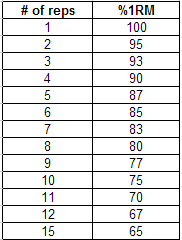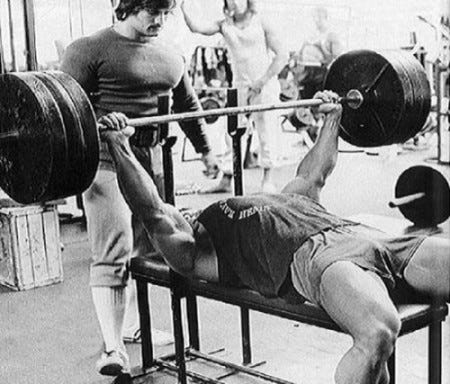Intensity can be defined as a percentage of your 1RM. It’s not a state of being. Meaning, intensity isn’t all about turning purple and spitting all over the place as you rip a deadlift off the ground in the position of a dog sh*tting a razor blade.
There are three common ways powerlifters quantity intensity. Percentages, RPE, and RIR. Percentages are common in traditional powerlifting programs and are great for intermediate and advanced lifters. I don’t recommend true 1RM’s for beginners.
First off, to truly set a 1RM you should be hitting a true 1 rep max single. The further you go from 1 rep to estimate a 1RM the less accurate the estimate will be. A 10 rep max isn’t as good of a predictor as a 2 rep max.
Secondly, females can usually handle more repetitions with a higher percentage than males just due to a less efficient nervous system. Females for example can typically hit 90% for a set of 5 while males can hit usually just 3 reps at 90%. If you’re looking for a decent 1RM estimate chart refer to the one below.
RPE: Rating of Perceived Exertion
Rating of perceived exertion, or RPE, is used to assign a rating to quantify intensity. Oftentimes this is used for just a top set but it can also be prescribed for all working sets for the respective exercise or workout. The RPE scale was first used as a scale of 1 to 20 (Borg scale) for cardiovascular exercise. Each number on the Borg scale corresponded with a multiple of 10 and was associated with heart rate. For example, an RPE 8 would be a heart rate of 80 beats per minute.
Powerlifters use a scale of 1 to 10 since heart rate isn’t a relevant metric for strength training. 1 out of 10 on the scale is the lowest rating and indicates a “light weight” and a 10 is the highest rating.
10 out of 10: maximal set.
The rep was a grinder and you couldn’t handle any more weight.
9 out of 10: 1 rep left in the tank.
The set was heavy but you could’ve done one more rep.
8 out of 10: 2 reps left in the tank.
The set was moderately heavy but you could’ve done two more reps.
7 out of 10: 3 reps left in the tank.
The set was moderate heavy and you could have done three more reps.
6 out of 10: 4 reps left in the tank.
The set was relatively light and you could have done four more reps.
Typically, when using RPE for lifting 6 is the lowest rating. It becomes difficult to accurately estimate RPE under 6 and for strength or hypertrophy purposes. Sets performed under an RPE of 6 are also not as effective at increasing muscle size. If you are however trying to increase speed or power, then sets under an RPE of 6 would be useful. However, it is still difficult to determine and something like percentages might work better in those circumstances.
“Sets performed under an RPE of 6 are also not as effective at increasing muscle size.”
RPE can also be set in halves (i.e., RPE 6.5, 7.5, 8.5, or 9.5). The halves indicate you could’ve done somewhere between the above reps or added weight. The halves are important to consider since they mean the set could have been heavier.
9.5 out of 10 means you had 0-1 reps left and could’ve added weight.
8.5 out of 10 means you had 1-2 reps left and could’ve added weight.
7.5 out of 10 means you had 2-3 reps left and could’ve added weight.
6.5 out of 10 means you had 3-4 reps left and could’ve added weight.
What is RIR
Reps in Reserve (RIR) is similar in concept to RPE. Repetitions in reserve simply states how many more reps you could have done. For example, an RIR of 3 indicates you could have done 3 more reps. You could also use ranges for RIR. RIR 2-3 for example would indicate that you could have done 2 or 3 more reps.
Typically RIR is a better choice for higher rep movements while RPE tends to be a better scale for lower reps. Oftentimes powerlifters will hit a top single at a certain RPE and it makes more sense to indicate how difficult the set was with RPE in this case than with RIR, although both are valid ways to assign difficulty.
It becomes more obvious at higher RPEs such as those between 8 and 10. An RPE of 10 and 9.5 are both an RIR of 0 for example, but knowing whether the set was a 9.5 or 10 is still valuable as a coach or athlete.
Examples:
3 RIR (or RPE 7) = 3 Reps In Reserve = 3 reps away from failure
2 RIR (or RPE 8) = 2 Reps In Reserve = 2 reps away from failure
1 RIR (or RPE 9) = 1 Rep In Reserve = 1 rep away from failure
0 RIR (or RPE 10) = 0 Reps In Reserve = 0 reps away from failure/max effort
A good rule of thumb is to use RPE for any set with 5 or less reps and to use RIR for any set with 6 or more reps. Although this rule isn’t set in stone it can help you more accurately determine the difficulty of your sets. Based on this information you can tell that RPE would be more useful for heavy sets in strength sports (strongman, powerlifting, olympic weightlifting) while RIR would be most useful for bodybuilding, muscular endurance, or accessory movements.
“A good rule of thumb is to use RPE for any set with 5 or less reps and to use RIR for any set with 6 or more reps”
Benefits of using RPE / RIR
The biggest benefit of using RPE or RIR is that you are able to autoregulate your training day to day. Strength ebbs and flows, your strength isn't the same today as it was yesterday or last week. Strength can be affected by things like hydration status, sleep and fatigue, nutrition, injury or soreness, psychology, and general recovery. Using an RPE or RIR prescription for a set can allow you to choose weights appropriately for how you feel that particular day rather than having to rely on a percentage that may not take into account undulating strength levels.
Periodizing Training with Autoregulation
There are countless ways to periodize a training program. The simplest way to use RPE or RIR in training would be to assign intensity (i.e., light, moderate, moderately heavy, and heavy) by ranges. You could tweak these ranges as you get more experience with using RPE and RIR. However, the potential for maximally recruiting muscle fibers increases the closer you approach failure. Keep this in mind when programming lower than RIR 4 or RPE 6. In circuits or finishers, there is a time to keep more reps in the tank but you should avoid using RPE or RIR in those circumstances and just assess intensity subjectively.
Light Intensity: RPE 6-7 or RIR 3-4
Moderate Intensity: RPE 7-8 or RIR 2-3
Moderately Heavy Intensity: RPE 8-9 or RIR 1-2
Heavy Intensity: RPE 9-10 or RIR 0-1
Summary
Both RPE and RIR can be useful tools to autoregulate training. Strength can fluctuate day to day, week to week, and month to month. Being able to still hit the intent of the exercise without having to rely on arbitrary percentages can assure that you hit the intensity you need to, when you need to, without overloading yourself with too much weight. When unsure of an RPE or RIR, use ranges to more accurately reflect where you ended up on the respective set. Fair warning, it can take a few weeks or months to accurately assess your intensity with RIR or RPE! Be patient, it takes practice. I suggest making notes frequently in your training log to shorten the learning curve. In time you will become more in tune with your training and can reap the benefits of autoregulated training.






